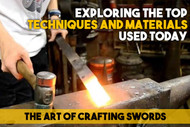The Art of Crafting Swords: Exploring the Top Techniques and Materials Used Today
Posted by SwordsSwords on Dec 16th 2022
For centuries, swords have been symbols of strength and power. From medieval knights to modern-day martial artists, swords have captured the imaginations of many. In recent years, sword-making has become a popular craft among blacksmiths and metalworkers. To create a functional and beautiful blade, craftsmen must employ a variety of techniques and materials. In this article, we’ll explore the top sword-making techniques and materials used today.
How It's Done: An Introduction to Modern Sword-Making
Today’s sword makers draw inspiration from a variety of sources, including historical designs and modern ergonomic features. Before beginning the crafting process, they must carefully consider the shape, length, and weight of the blade. Then, they must select the suitable material and method for forging the blade. Swordmakers usually employ a combination of manual and automated techniques, such as hammering, folding, and tempering.
The Most Popular Materials Used in Swordmaking
The material used to make a sword greatly impacts its durability, aesthetics, and performance. While some swords are still crafted from traditional materials such as steel and iron, today’s sword makers often opt for lighter and more durable materials. The most popular materials used in sword-making include stainless steel, titanium, and carbon fiber.
Stainless Steel – This is the most popular material for modern sword-making. It is highly resistant to corrosion and provides a durable, sharp edge.
Titanium – Titanium is a lightweight, yet strong and durable material. It is often used to make swords for martial arts and competition.
Carbon Fiber – This is a lightweight, yet strong material. It is often used to make swords with a unique and eye-catching appearance.
The Benefits of Hand-Forging
While modern sword-making techniques rely heavily on machines, hand-forging remains popular among craftsmen. This method requires the use of hand tools and hammers to shape and refine the blade. Hand-forging has a number of benefits, including improved precision and control, and a unique finish. It is also a great way to add artistic elements to the blade.
Sharpening and Polishing
Once the blade has been forged, the next step is to sharpen and polish it. This is done with a variety of tools, such as whetstones, grinding wheels, and buffing compounds. This process removes any imperfections and creates a sharp, smooth edge.
The Final Touches
The last step in sword-making is to add the finishing touches. This includes adding a handle, guard, and pommel. The handle can be made from a variety of materials, such as leather, wood, and metal. Adding these elements is a great way to personalize the sword and make it unique.
Crafting a functional and beautiful sword requires a combination of skill, precision, and creativity. By combining traditional techniques with modern materials, sword makers can create stunning blades that are both functional and beautiful. Whether you’re looking for a handmade work of art or a functional tool, modern sword-making techniques have something for everyone.
SwordsSwords products are a unique and timeless art form that has been around for centuries. They require a great deal of skill, knowledge, and creativity to craft. Today, there are many top techniques and materials used for crafting swords, each with its own benefits and drawbacks. By understanding the intricacies of the art of crafting swords, one can create a truly beautiful and functional weapon. Furthermore, the techniques and materials used for sword crafting today are more diverse and advanced than ever, allowing for a truly unique and stunning sword that has the potential to last a lifetime.

